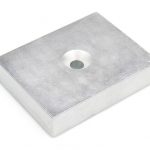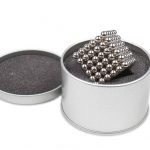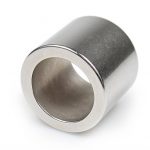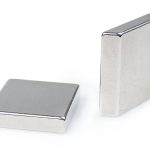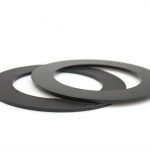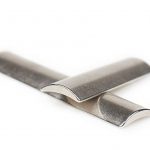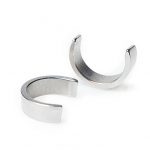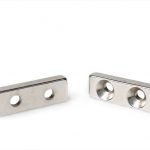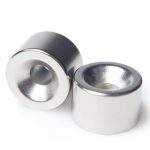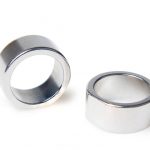NdFeB Magnets
- General information
- Learn More
- Property Table
- Photo Gallery

- Sintered NdFeB: N33 – 52 (M,H,SH,UH,EH,AH)
- Bonded NdFeB: BNM 5 – 12
NdFeB is the strongest type of permanent magnet commercially available.
- Higher remanence (the strength of the magnetic field)
- Higher coercivity (resistance to being demagnetized)
- Higher energy product (density of magnetic energy)
We are able to custom the shape and coating for your specific requirements.
General Introduction
Features
Typical Grades
Bonded NdFeB: BNM 5 – 12
Property
- Remanence (Br), measure the strength of the magnetic field;
- Coercivity (Hcb / Hcj), the material’s resistance to becoming demagnetized;
- Energy product (BHmax), the density of magnetic energy, which relates to the magnetic flux output per unit volume. Higher values indicate stronger magnets;
- Curie temperature (Tc), the temperature at which the material loses its magnetism.
Shape
Disk/Cylinder, Bar/Block, Ring, Arc, Countersunk, etc.
Custom design is available to us for client`s specific needs.
Coating
NdFeB tends to be vulnerable to corrosion, which could cause serious deterioration, including crumbling of a magnet into a powder of small magnetic particles, or spalling of a surface layer. Coating prevents these magnets from oxidation.
Widely used coatings are NiCuNi, Ni, Zn, Epoxy, as well as some special coatings, for example, Copper, Gold, Silver, and etc.
Application
Neodymium magnets have replaced Alnico and Ferrite magnets in many of the myriad applications in modern technology where strong permanent magnets are required, because their greater strength allows the use of smaller, lighter magnets for a given application. Some examples are:
- Permanent Magnet Motor/Generator
- Magnetic Separator/ Filter
- Magnetic Lifter
- Magnetic Pot/Hook
- Magnetic Bearings and Couplings
- Magnetic Sensors
- Magnetic Resonance Imaging (MRI)
- Bench-top NMR spectrometers
- Loudspeakers and headphones
Production
Sintered NdFeB:
Raw Materials → Melting → Pulverizing → Aligning & Pressing → Sintering → Annealing → Machining → Surface Treating → Magnetizing → Inspecting → Packing & Delivery
Bonded NdFeB:
Rapidly quenched NdFeB Powder → Particle size adjustment → Kneading with other material → Molding → Secondary Process, Surface Treating, Grinding → Inspecting → Packing & Delivery
General Introduction
Features
Typical Grades
Bonded NdFeB: BNM 5 – 12
Property
- Remanence (Br), measure the strength of the magnetic field;
- Coercivity (Hcb / Hcj), the material’s resistance to becoming demagnetized;
- Energy product (BHmax), the density of magnetic energy, which relates to the magnetic flux output per unit volume. Higher values indicate stronger magnets;
- Curie temperature (Tc), the temperature at which the material loses its magnetism.
Shape
Disk/Cylinder, Bar/Block, Ring, Arc, Countersunk, etc.
Custom design is available to us for client`s specific needs.
Coating
NdFeB tends to be vulnerable to corrosion, which could cause serious deterioration, including crumbling of a magnet into a powder of small magnetic particles, or spalling of a surface layer. Coating prevents these magnets from oxidation.
Widely used coatings are NiCuNi, Ni, Zn, Epoxy, as well as some special coatings, for example, Copper, Gold, Silver, and etc.
Application
Neodymium magnets have replaced Alnico and Ferrite magnets in many of the myriad applications in modern technology where strong permanent magnets are required, because their greater strength allows the use of smaller, lighter magnets for a given application. Some examples are:
- Permanent Magnet Motor/Generator
- Magnetic Separator/ Filter
- Magnetic Lifter
- Magnetic Pot/Hook
- Magnetic Bearings and Couplings
- Magnetic Sensors
- Magnetic Resonance Imaging (MRI)
- Bench-top NMR spectrometers
- Loudspeakers and headphones
Production
Sintered NdFeB:
Raw Materials → Melting → Pulverizing → Aligning & Pressing → Sintering → Annealing → Machining → Surface Treating → Magnetizing → Inspecting → Packing & Delivery
Bonded NdFeB:
Rapidly quenched NdFeB Powder → Particle size adjustment → Kneading with other material → Molding → Secondary Process, Surface Treating, Grinding → Inspecting → Packing & Delivery
